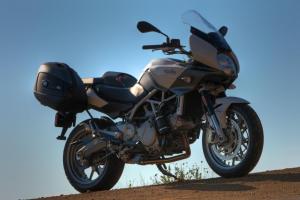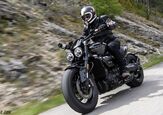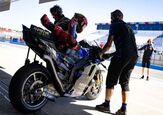2010 Honda NT700V Vs. Aprilia Mana 850 GT ABS - Motorcycle.com
I don’t know about you, but I’ve reached a stage (or age!) in life where I embrace conveniences that make everyday life as simple as possible. This is especially true of my riding.
In most instances I’ve learned to park my ego, foregoing the need to only ever ride the fastest, biggest or loudest. When the right time or right bike calls for it, I’ll act a fool, but generally, I like my comfort when riding.
I have a mantra that sums up my mentality: Life behind the windshield is good.
Last year we reviewed the Aprilia Mana 850, a bike that has Convenience as its middle name. But the standard Mana didn’t fit my ideal of Comfort as King since it lacked wind protection.
Not until this year did America receive the Mana 850 GT ABS.
Standard on the GT is ABS, and a small front fairing with a moderately adjustable windscreen. There we go! Now the Mana looks like it might fill my lazy man needs quite nicely.
Also new to the U.S. for 2010 is Honda’s NT700V (alternatively known as the Deauville for the European market). The ST1300’s little brother comes standard with integrated hardbags and manually adjustable windscreen; ABS is optional.
Where large-displacement land rockets adorned with big screens and electronic wizardry, like BMW’s K1300GT or Kawi’s recently updated Concours14, have come to define the sport-touring segment, the duo of the Aprilia and Honda might just create a new sub-segment: sport-touring lite!
At first, mulling over the qualities of each bike separately, both machines seemed like oddballs with no direct competitors. But the more we thought about it, the more it became obvious how well this pair might match up, despite what at first seemed like an unfair engine room advantage in the Mana’s favor.
Surprisingly, the bikes locked horns in terms of both horsepower and torque.
If you’ll recall from last year’s review, the Mana is powered by an 839cc, liquid-cooled, fuel-injected, SOHC, 90-degree V-Twin with four valves per cylinder. But the real trick up the Mana’s sleeve is its transmission: it’s an automatic!
As we discovered last year, Aprilia sourced the mill from the Gilera GP800, one of the Italian giant’s many scooter brands. However, the Mana is more than just a basic-but-big scooter engine. A key feature of the Mana is the ability to operate its transmission in fully automatic mode or in sequential semi-manual shifting mode with seven pseudo “gears.” Furthermore, a rider can choose from three engine maps (Rain, Touring and Sport) similar to those found on the Aprilia Shiver.
The Mana strikes the first blow for convenience with its twist ‘n’ go ease-of-use that’s further enhanced by selectable mapping.
For all intents, the dyno contest resulted in a dead heat, but on paper we expected maybe the Mana would show a notable torque advantage once we strapped both bikes to the dyno at Gene Thomason Racing, Torrance, California (310/618-1908).
Although the NT700V’s 680cc, liquid-cooled, fuel-injected, SOHC, four-valves-per-cylinder 52-degree Vee with traditional 5-speed gearbox and shaft final drive (the Mana is chain final drive) wouldn’t seem able to go head-to-head, it managed to produce the same rear-wheel horsepower reading as the larger displaced Mana, with both bikes churning out just under 54 hp. And the Honda’s peak torque reading of 40.9 ft-lbs bested the Aprilia by 0.6 ft-lbs.
After riding each sled back-to-back (but before dyno testing), our seat o’ the pants eval of engine performance had us feeling like the Honda might’ve made even more ponies than the Mana, as the NT gives the sensation of stronger drive out of the corner. The impression that the Honda is more powerful off the bottom is all the more odd when reviewing dyno data that reveals the Mana is the gruntier of the two between roughly 2500 to 5700 rpm. It seems that the Mana’s CVT somewhat blunts its initial acceleration.
Also worth noting is the Honda’s smoother nature at freeway pace. Some buzz is noticeable from the NT’s Twin, but at roughly 80 mph the Mana’s mill transmits more vibes to the pegs (particularly to the left for some reason) than does the Honda’s engine.
The GT still employs the same excellent dual four-piston binders as found on the standard Mana, only now the pot is sweetened with the aforementioned ABS.
For parity’s sake we procured an NT700V with ABS, a $1000 option. Had we not chosen ABS on the NT, it still would’ve come with Honda’s Combined (linked) Braking System. Although we felt the Mana’s brakes offered better feel and stopping power, the gap in performance over the Honda’s brakes was marginal.
Getting some front-end dive when applying only the rear brake on the NT (the rear is linked to the front, but not vice-versa) takes some getting used to, but simultaneously applying front and rear brakes results in impressive stopping force on the Honda.
The Mana’s slightly more aggressive chassis dimensions imply that it might be a sharper handler than the NT, but the reality is the bikes are pretty evenly matched when dicing between corners. Steering effort is lighter on the Honda despite its slightly longer wheelbase (58.1” vs. 57.5”) and trail (4.5” vs. 4.05”). And its 28.0-degree rake is remarkably lazier when compared to the Mana’s sporty 24.0 degrees. The NT’s significantly narrower rear tire (150/70-17 vs. 180/55-17) lends to its light and responsive steering.
Factor in Honda’s claimed real-world weight of 562 lbs for the NT, and its prowess is all the more impressive. Aprilia hasn’t posted any claimed weight for the 2010 GT, but we know that the pre-GT Mana weighs in with its tank full at about 515 lbs. The addition of the GT’s fairing and ABS system will still keep it about 20 lbs lighter, but that gap closes down to almost nothing once the Mana’s accessory saddlebags and brackets are added.
The Mana’s inverted, non-adjustable 43mm fork is more substantial than the NT’s non-adjustable right-side-up 41mm fork, but discerning superior damping qualities ‘tween them is tough.
The Aprilia offers a secure, planted feel throughout the arc of a turn, thanks in part to a low center of gravity created by carrying most of its fuel under the rider. But its linkage-less shock’s suspension action isn’t as progressive as the Honda’s more traditional shock with linkage set up. The Honda’s suspension offers a better balanced feel overall. Both scoots provide easy remote adjustment of shock preload via a hand dial.
With all the dry stuff out of the way, let’s get onto what really matters on these two!
A tit-for-tat of conveniences
At this point you might think there isn’t much separating this pair in terms of performance, and in that you’d be spot on. Unfortunately, looking for a standout among the amenities found on each motorcycle doesn’t lead to one bike blowing the other out of the water either – of course, if for you a push-button transmission is a major high point, you might then think the Mana is the convenience leader.
Earlier we pointed out how we chose the ABS option for the Honda since ABS comes standard on the Aprilia. Now it’s time for the ‘Priller to pony up.
The NT700V has cleanly integrated hardbags along with two small-ish in-fairing glove boxes as part of its touring repertoire; the Aprilia has no storage beyond that found in its faux fuel tank.
And this feature on the Mana is indeed super handy. At the push of a button (so long as the ignition is switched on) the Mana’s “fuel tank” opens up to reveal a cavernous compartment big enough to hold a helmet, and it’s graced with a car trunk-type light and 12v power socket.
However, we found that not all helmets will fit in this space as intended. If you have a helmet with some type of decorative rear spoiler, or something similar, there’s a good chance you’ll have the same experience we did wherein the compartment lid wouldn’t fully close.
Back to baggage, or the lack thereof. The Aprilia-branded Givi hardbags, and the racks needed to hold them, you see on the Mana are a combined $937.44 worth of accessories.
The bags attach and detach, as well as open and close, with little effort. But believe it or not, despite their voluminous appearance, we couldn’t shut them completely with a full-face helmet inside. With the Honda’s narrow and smaller capacity side cases we knew a helmet wouldn’t fit, but on the Aprilia this came as a surprise. Of course, depending on the helmet you use, or if you never lock your lid in the luggage, this may not be a drawback.
One of two things that separate a Mana 850 from a Mana 850 GT is a fairing with integrated windscreen (the other item is, again, ABS).
The Mana’s screen is too narrow for encompassing wind protection, and its shape and angle seemed to direct airflow at my helmet rather than over it, causing some buffeting at freeway speeds. Despite these qualities, I can’t help but think of my windscreen mantra mentioned above. Some wind protection is better than none at all.
"The Mana’s screen is too narrow for encompassing wind protection..."
The NT700V doesn’t enjoy the luxury of electronic adjustment of its windscreen like its bigger brother ST1300 does. But the NT’s screen is large enough, and its range of manual adjustment wide enough, to be very effective at blocking most of the windblast when set in its highest position. Furthermore, I didn’t experience any buffeting worth mentioning.
| Finally, some small but significant observations |
| • The Honda’s saddle, a scant 0.2 inches higher than the Aprilia’s 31.5-inch seat height, felt roomier (including the pillion) and softer. |
| • A center stand is an accessory on the Mana ($246.05) but standard on the NT. |
| • The Honda’s instruments are mostly analog, the Mana’s consist of a white-faced speedo and large LCD panel. |
| • The NT managed an observed miserly 42 mpg from its 5.2-gallon tank, while we recorded 37.5 mpg from the Mana’s 4.2-gallon under-seat tank. |
While we weren’t shocked the Honda’s average fuel economy reading enthusiastically displayed 50 mpg, the Aprilia, strangely, erred on the side of caution. Its LCD was reporting an average of 27.3 mpg, much lower than what we observed. We had a similar experience last year when evaluating the standard Mana.
Commuters, sporty light tourers, everyday all ‘rounders
With each of these bikes there’s more to like than dislike. Both make everyday riding/commuting a breeze with useful, convenient features. And weeklong trips are entirely within reach for either bike.
Merely twisting to go is where the Mana 850 GT shines. The simplicity of an auto-trans bike with a very functional and easily accessed storage compartment directly in front of the rider makes running errands around town effortless. Yet, with the Mana you also have a sporting motorcycle that’s capable of confounding sportbikes in the canyons and curves. Furthermore, the Mana GT’s employment of technology, ease-of-use and attractive styling is undeniable.
It’s hard to pick one bike over the other in terms of bang for the buck, as everyone will have different priorities.
For some, the Mana is a technical wonder, and its $10,599 base price could seem like a steal. On the other hand, no real luggage on a bike that touts itself a sport-tourer simply by throwing on ABS and a windscreen could be perceived as a bike that’s long on claims and short on delivery.
Although the NT doesn’t boast any fancy pushbutton tech, and you still need to squeeze a clutch lever and toe a shifter to keep moving forward, the Honda with ABS rings in at $10,999, only $400 more than the Mana GT. But take the Mana with the accessories we ordered to create two similarly equipped motorcycles, and the Aprilia’s as-tested price jumps to $11,822, nearly a full grand more than the Honda.
Consider the Honda’s sleekly integrated luggage, very practical wind protection and original-equipment center stand, and the NT700V positions itself as the bike that may soon lead the emerging sport-touring lite segment.
Related Reading
2010 Honda NT700V Review
2010 Aprilia Mana 850 GT ABS Review
2009 Aprilia Mana 850 GT ABS Review
2009 Aprilia Mana Review
All Things Aprilia on Motorcycle.com
All Things Honda on Motorcycle.com
More by Pete Brissette







































Comments
Join the conversation